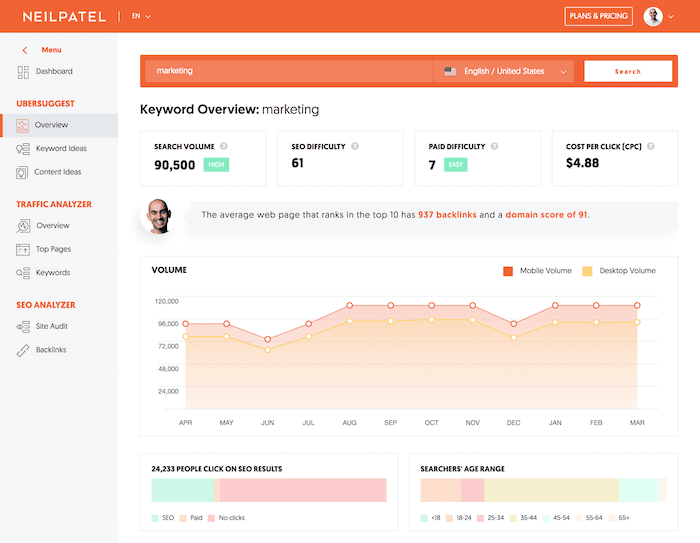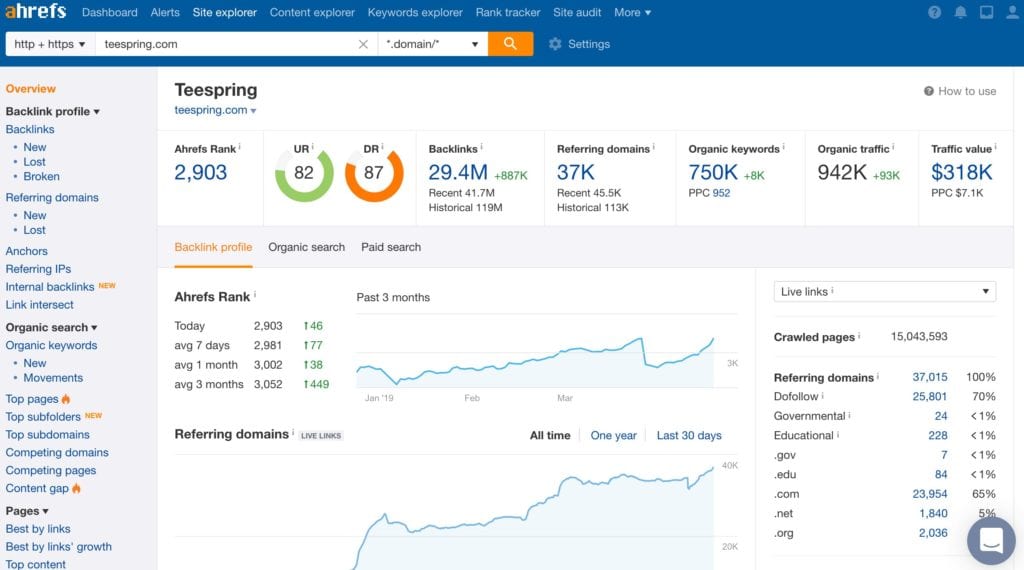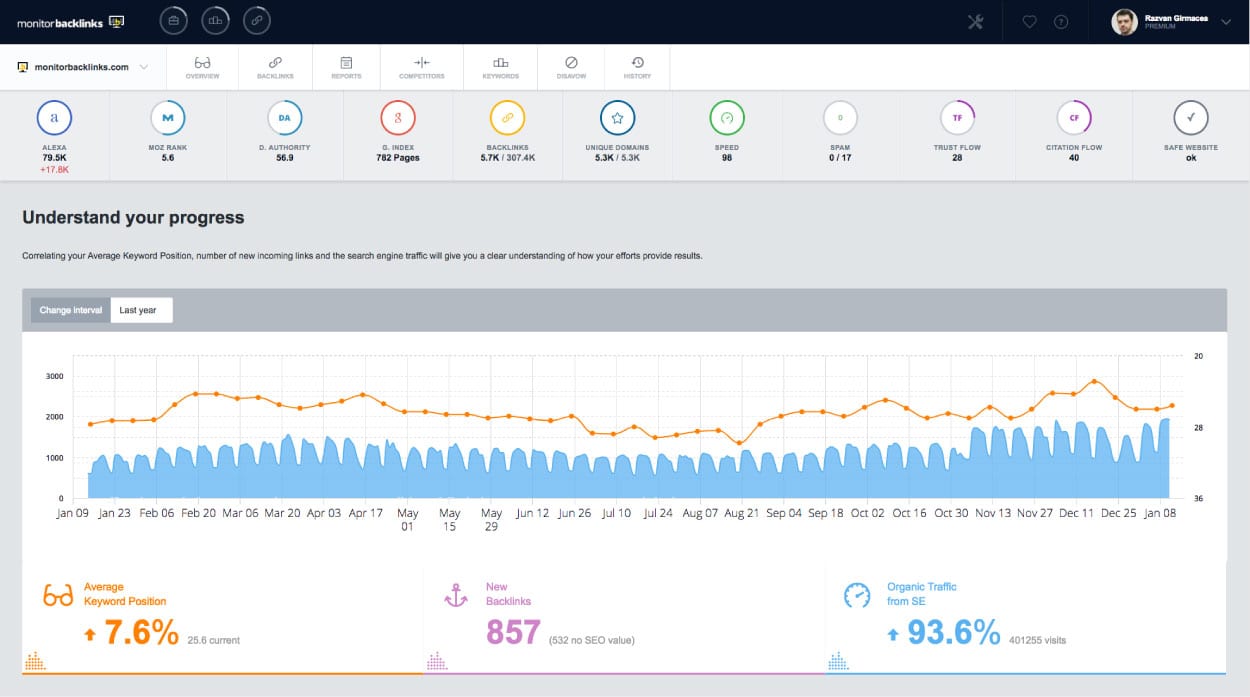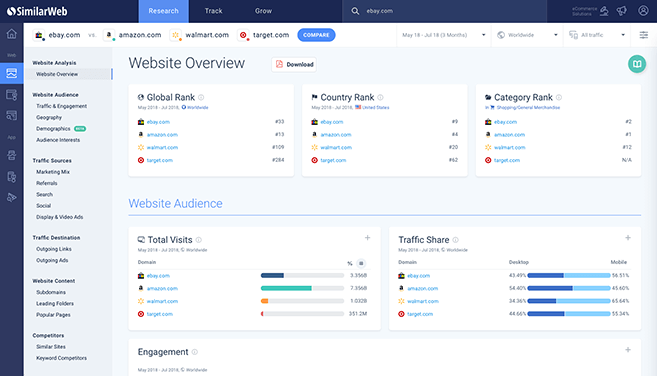5 Best SEO Competitor Analysis Tools For Beginners
Competitor analysis is a critical part of SEO. When you know the reasons why your competitors are outranking, you can take proper steps to fix the differences.
As a beginner, doing SEO competitor analysis is not easy because there are so many different tools in the market, and each of them offers unique metrics.
If you are confused which SEO tool you should use as a newbie then this article will discuss the top five SEO competitor analysis tools that are best for beginners.
Let’s begin!
1. Ubersuggest
Ubersuggest by Neil Patel is one of the best SEO competitor analysis tools in the market. I use it daily because the tool offers so much data for free. The free data provided by Ubersuggest is more than any other SEO tool.
Enter your competitor domain in the search bar. The four crucial SEO metrics that you see are:
- Organic traffic to the site.
- The total number of organic keywords where the site ranks in the top 100 search results.
- The domain score which is the overall strength of the website. Higher the domain score, the more valuable the website.
- The total number of backlinks.
When you click on the organic keywords metric, you see a list of all the top-ranking organic keywords. You can filter this data based on locations like the US, UK, India, etc. What’s best about this data is that you can see:
- The search volume of the keywords.
- The current SERP of your competitor.
- The number of estimated visits that a particular keyword is driving to your competitor’s site.
- The number of links needed to get your website to position #1 in Google.
 When you click on the backlinks section, you see the pages that link to your competitor website, their domain score, page score, the link type, the anchor text, and the time when the link was first detected and last crawled.
When you click on the backlinks section, you see the pages that link to your competitor website, their domain score, page score, the link type, the anchor text, and the time when the link was first detected and last crawled.
Another useful feature of Ubersuggest is the Top Traffic Pages. This feature lets you see all the pages on your competitor’s site, driving the maximum traffic and the number of links required to outrank them.
When you have such robust data in your hands, you can easily supercharge your SEO campaign.
The tool is easy to use, does not consist of confusing metrics that are hard to understand. The best part is, Ubersuggest offers the majority of the data to be accessed for free.
2. Ahrefs
Another useful SEO competitor analysis tool is the Ahrefs Site Explorer. This tool might be a bit tougher on beginners, but it can certainly provide an in-depth look at your competitor’s backlink profile and search traffic data.
Enter your competitor’s domain in the search bar, and Ahrefs will return the following data:
- Total organic traffic.
- The number of organic keywords.
- The number of backlinks.
- The anchor text of the links.
- The overall traffic value.
- Ahrefs Rank.
- The top pages and the content gap.

What I particularly like about Ahrefs is that you can see the traffic value associated with every top-ranking page. This metric is useful because a high traffic value indicates the keyword gets a higher conversion. People pay more for keywords that have higher chances of conversion, and since Ahrefs uses paid search data, the metric presents the conversion value of a keyword in terms of traffic value.
As an SEO beginner, you should know the keywords that are the most valuable for your business to build a proper content marketing funnel. Else, you would be wasting your efforts on a keyword that has little to no SEO value.
Another useful feature that Ahrefs offers is the content gap. This option lets you know the keywords your competitor ranks for, but your site doesn’t.
But, you can’t start using Ahrefs for free. You only need to pay $7 for a seven-day trial. In this trial period, you can analyze your competitors and get all the data required to run your SEO campaign. After that, when your campaign starts to bring in some results, you can subscribe to the paid plans from $99.
3. SE Rankings
SE Ranking is one of the most underrated SEO tools. It displays tons of useful SEO information that is needed to defeat your organic competitors.

Enter your competitor domain in the search bar and press enter. The tool will return all the keywords where the domain is ranking in organic search. Besides, if you want to identify your top competitors for a search query, then you can enter your main money keyword, and the tool will return a list of all the top competitors for that keyword.
Here are the top SEO data returned by this tool:
- The number of organic keywords the site ranks for.
- Estimated traffic and the traffic cost.
- The number of keywords that have improved in rankings.
- The number of keywords that have decreased in rankings.
- Distribution of organic keyword rankings like how many keywords are ranking in 1-5, 6-10, 11-20, 21-50, and 51-100.
SERanking is a useful SEO tool for newbies because it is simple to use, and you can target competitor keywords that are ranking on specific positions like under 10 or under 50.
SERanking is one of the most affordable SEO tools. The pricing starts at $39/month.
4. Monitor Backlinks
Links are one of the major factors for acquiring higher organic rankings. Monitor Backlinks offers a detailed overview of your competitor’s links that gives you a clear understanding of the work required to produce noticeable results.
Enter your competitor’s domain in the search bar, and the tool will return the following information:
- Alexa Rank, Moz Rank, and Domain Authority.
- The number of pages indexed on Google.
- The number of backlinks and the total referring domains.
- Trust Flow, Citation Flow, and website speed.
- Anchor text distribution and IP location.

Monitor Backlinks is useful because it gives you an idea of essential SEO metrics that impact the organic rankings like the DA, PA, TF, and CF. When you know these metrics associated with your competitor’s domain and all the domains that are pointing to your competitor, you can take out an average score of DA, and TF that you need to acquire links from.
Besides, you can set up email alerts of your competitor links like whenever your competitors acquire a link; you receive an email with the link data. This way, you can keep track of all your competitor’s link building activities.
If you only need to check your competitor’s link data, you can subscribe to the 30-day free trial. However, if you wish to set up email alerts for at least a year, you should subscribe to the paid plan starting at $47/month.
5. Similar Web
Similar Web is another unique SEO tool that offers some vital data that no other SEO tool provides.
Enter your competitor domain in the search bar, and the tool returns crucial data such as:
- An overview of what the company does and when it was founded.
- The global rank, the country rank, and the category rank of the domain. The lesser the rank, the better.
- The total traffic to the website filtered by country.
- The top traffic sources for Ahrefs, which includes the top referral traffic sources.
Similar Web is useful only when you want to spy on a competitor with a massive organic presence. For smaller websites, you won’t get enough data.

What I like the most about this tool is that I can see the top referral traffic sources to my competitor’s domain. This data is useful because I can find the sites driving traffic to the competitor’s website. I can plan a strategy to acquire links from these domains. You can use this tool for free.
Conclusion
Keeping an eye on your competitors is vital for your SEO success. The above five SEO tools are the best, and they offer some fantastic features to upgrade your existing SEO strategy. If you ask me, then two of my favorite tools are Ubersuggest and SE Rankings. Which tool is your favorite? Please let me know in the comments below.









